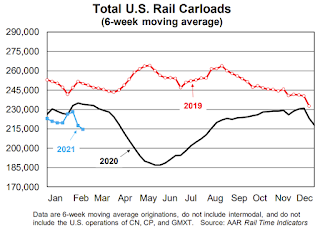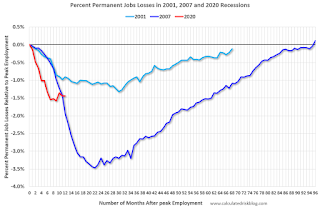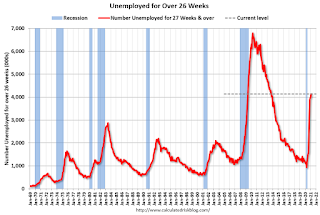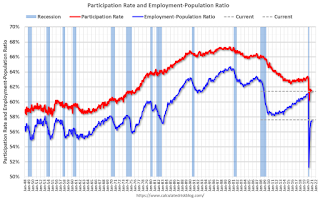by Calculated Risk on 3/05/2021 02:32:00 PM
Friday, March 05, 2021
Q1 GDP Forecasts: Around 5.5% SAAR
From Merrrill Lynch:
We continue to track 5.5% for 1Q GDP tracking. [Mar 5 estimate]From Goldman Sachs:
emphasis added
We left our Q1 GDP tracking estimate unchanged at +5.5% (qoq ar). [Mar 5 estimate]From the NY Fed Nowcasting Report
The New York Fed Staff Nowcast stands at 8.6% for 2021:Q1 and 4.0% for 2021:Q2. [Mar 5 estimate]And from the Altanta Fed: GDPNow
The GDPNow model estimate for real GDP growth (seasonally adjusted annual rate) in the first quarter of 2021 is 8.3 percent on March 5, down from 10.0 percent on March 1. [Mar 5 estimate]
AAR: February Rail Carloads down 11.1% YoY, Intermodal Up 1.8% YoY
by Calculated Risk on 3/05/2021 12:50:00 PM
From the Association of American Railroads (AAR) Rail Time Indicators. Graphs and excerpts reprinted with permission.
The U.S. freight rail network is subject to, and sometimes at the mercy of, hurricanes, tornadoes, floods, and other whims of nature. In February, the whims included exceptionally cold and icy conditions in most of the country, including in many areas that aren’t used to it. For rail, it meant reduced operations and, in some areas, complete temporary shutdowns. It was so bad, in fact, that total U.S. rail carloads in the third week of February were the lowest of any week in our records that go back to 1988. Volumes recovered the next week, but the net impact was materially lower rail volumes in February.
In February 2021, U.S total carloads were down 11.1% from February 2020, the biggest percentage decline in six months ... However, U.S. intermodal originations were 1.8% higher in February 2021 than in February 2020, continuing what’s now a streak of seven straight months of year-over-year gains.
emphasis added
 Click on graph for larger image.
Click on graph for larger image.This graph from the Rail Time Indicators report shows the six week average of U.S. Carloads in 2019, 2020 and 2021:
In February, U.S. railroads originated 824,636 total carloads, down 11.1% (102,972 carloads) from February 2020. That’s the biggest year-over-year percentage decline in six months, much worse than the 2.1% decline in January 2021 and 3.7% decline in December 2020. In the third week of February, when the worst of the bad weather struck, the year-over-year decline was 26.3%.
 The second graph shows the six week average of U.S. intermodal in 2019, 2020 and 2021: (using intermodal or shipping containers):
The second graph shows the six week average of U.S. intermodal in 2019, 2020 and 2021: (using intermodal or shipping containers):U.S. railroads originated 1.02 million intermodal containers and trailers in February 2021, an average of 253,999 per week. That’s 1.8% higher than the weekly average in February 2020, continuing what’s now a streak of seven straight months of year-over-year intermodal gains. U.S. intermodal originations averaged 293,305 per week in January 2021, an all-time record.Note that rail traffic was weak prior to the pandemic, however intermodal has come back strong.
Trade Deficit Increased to $68.2 Billion in January
by Calculated Risk on 3/05/2021 10:38:00 AM
From the Department of Commerce reported:
The U.S. Census Bureau and the U.S. Bureau of Economic Analysis announced today that the goods and services deficit was $68.2 billion in January, up $1.2 billion from $67.0 billion in December, revised.
January exports were $191.9 billion, $1.8 billion more than December exports. January imports were $260.2 billion, $3.1 billion more than December imports.
emphasis added
 Click on graph for larger image.
Click on graph for larger image.Both exports and imports increased in January.
Exports are down 7.6% compared to January 2020; imports are up 3.2% compared to January 2020.
Both imports and exports decreased sharply due to COVID-19, and have now bounced back (imports much more than exports),
The second graph shows the U.S. trade deficit, with and without petroleum.
 The blue line is the total deficit, and the black line is the petroleum deficit, and the red line is the trade deficit ex-petroleum products.
The blue line is the total deficit, and the black line is the petroleum deficit, and the red line is the trade deficit ex-petroleum products.Note that the U.S. exported a slight net positive petroleum products in recent months.
Oil imports averaged $42.50 per barrel in January, up from $38.30 per barrel in December, and down from $52.24 in January 2020.
The trade deficit with China increased to $26.3 billion in January, from $26.1 billion in January 2020.
Comments on February Employment Report
by Calculated Risk on 3/05/2021 09:13:00 AM
The headline jobs number in the February employment report was well above expectations, and employment for the previous two months was revised up slightly.
Earlier: February Employment Report: 379 Thousand Jobs, 6.2% Unemployment Rate
In February, the year-over-year employment change was minus 9.475 million jobs. This will turn positive in April due to the sharp jobs losses in April 2020.
Permanent Job Losers
 Click on graph for larger image.
Click on graph for larger image.This graph shows permanent job losers as a percent of the pre-recession peak in employment through the December report. (ht Joe Weisenthal at Bloomberg)
This data is only available back to 1994, so there is only data for three recessions.
In February, the number of permanent job losers was mostly unchanged at 3.497 million from 3.503 million in January.
Prime (25 to 54 Years Old) Participation
 Since the overall participation rate has declined due to cyclical (recession) and demographic (aging population, younger people staying in school) reasons, here is the employment-population ratio for the key working age group: 25 to 54 years old.
Since the overall participation rate has declined due to cyclical (recession) and demographic (aging population, younger people staying in school) reasons, here is the employment-population ratio for the key working age group: 25 to 54 years old.The prime working age will be key in the eventual recovery.
The 25 to 54 participation rate was unchanged in February at 81.1% from 81.1% in January, and the 25 to 54 employment population ratio increased to 76.5% from 76.4% in January.
Part Time for Economic Reasons
 From the BLS report:
From the BLS report:"The number of persons employed part time for economic reasons, at 6.1 million, changed little in February but is up by 1.7 million over the year. These individuals, who would have preferred full-time employment, were working part time because their hours had been reduced or they were unable to find full-time jobs."The number of persons working part time for economic reasons increased in February to 6.088 million from 5.954 million in January.
These workers are included in the alternate measure of labor underutilization (U-6) that was unchanged at 11.1% in February. This is down from the record high in April 22.9% for this measure since 1994.
Unemployed over 26 Weeks
 This graph shows the number of workers unemployed for 27 weeks or more.
This graph shows the number of workers unemployed for 27 weeks or more. According to the BLS, there are 4.148 million workers who have been unemployed for more than 26 weeks and still want a job.
This does not include all the people that left the labor force. This will be a key measure to follow during the recovery.
Summary:
The headline monthly jobs number was well above expectations, and the previous two months were revised up 38,000 combined. The headline unemployment rate declined to 6.2%.
February Employment Report: 379 Thousand Jobs, 6.2% Unemployment Rate
by Calculated Risk on 3/05/2021 08:44:00 AM
From the BLS:
Total nonfarm payroll employment rose by 379,000 in February, and the unemployment rate was little changed at 6.2 percent, the U.S. Bureau of Labor Statistics reported today. The labor market continued to reflect the impact of the coronavirus (COVID-19) pandemic. In February, most of the job gains occurred in leisure and hospitality, with smaller gains in temporary help services, health care and social assistance, retail trade, and manufacturing. Employment declined in state and local government education, construction, and mining.
...
The change in total nonfarm payroll employment for December was revised down by 79,000, from -227,000 to -306,000, and the change for January was revised up by 117,000, from +49,000 to +166,000. With these revisions, employment in December and January combined was 38,000 higher than previously reported.
emphasis added
 Click on graph for larger image.
Click on graph for larger image.The first graph shows the year-over-year change in total non-farm employment since 1968.
In February, the year-over-year change was negative 9.475 million jobs.
Total payrolls increased by 379 thousand in February. Private payrolls increased by 465 thousand.
Payrolls for December and January were revised up 38 thousand, combined.
 The second graph shows the job losses from the start of the employment recession, in percentage terms.
The second graph shows the job losses from the start of the employment recession, in percentage terms.The current employment recession was by far the worst recession since WWII in percentage terms, and is still at the worst of the "Great Recession".
The third graph shows the employment population ratio and the participation rate.
 The Labor Force Participation Rate was unchanged at 61.4% in February. This is the percentage of the working age population in the labor force.
The Labor Force Participation Rate was unchanged at 61.4% in February. This is the percentage of the working age population in the labor force. The Employment-Population ratio increased to 57.6% (black line).
I'll post the 25 to 54 age group employment-population ratio graph later.
 The fourth graph shows the unemployment rate.
The fourth graph shows the unemployment rate. The unemployment rate decreased in February to 6.2%.
This was well above consensus expectations, and December and January were revised up by 38,000 combined.
Black Knight: Number of Homeowners in COVID-19-Related Forbearance Plans Decreased
by Calculated Risk on 3/05/2021 08:23:00 AM
Note: Both Black Knight and the MBA (Mortgage Bankers Association) are putting out weekly estimates of mortgages in forbearance.
This data is as of March 2nd.
From Black Knight: Forbearance Plans Decrease, But So Does Rate of Recovery
The number of homeowners in active forbearance plans improved this week, falling by 22,000 (-0.8%) from last week, driven by month-end expiration activity. Improvements were seen across investor classes, with FHA/VA forbearances falling by 13,000; GSE forbearances declining by 8,000 and portfolio/PLS forbearances falling by a more modest 1,000 this week.The number of loans in forbearance has declined slightly over the last few months.
With more than 100,000 forbearance plans still listed with February month-end expirations, additional reviews and removal activity may be seen in the coming days.
Despite the weekly decline in outstanding forbearance plans, the month-over-month rate of improvement slowed, falling from -2% to -1.3%. This continues the trend we’ve been seeing in recent months of an incremental and sluggish rate of recovery.
Click on graph for larger image.
As of March 2, 2.69 million (5.1% of) homeowners remain in forbearance, including 9.2% of FHA/VA, 3.2% of GSE, and 5.2% of portfolio/private mortgages.
All eyes will be on early April forbearance volumes to see how many of the 1.1 million plans currently set to expire at the end of March – just over 600,000 of which are 12-month expirations – will exit their plans, and what share will further extend their participation in available forbearance offerings.
emphasis added
Thursday, March 04, 2021
Friday: Employment Report, Trade Deficit
by Calculated Risk on 3/04/2021 09:17:00 PM
My February Employment Preview
Goldman February Payrolls Preview
Friday:
• At 8:30 AM ET, Employment Report for February. The consensus is for 148,000 jobs added, and for the unemployment rate to increase to 6.4%.

This graph shows the job losses from the start of the employment recession, in percentage terms.
The current employment recession was by far the worst recession since WWII in percentage terms, and the worst in terms of the unemployment rate.
• Also at 8:30 AM, 8:30 AM: Trade Balance report for January from the Census Bureau. The consensus is the trade deficit to be $67.5 billion. The U.S. trade deficit was at $66.6 billion in December.
March 4 COVID-19 Test Results and Vaccinations
by Calculated Risk on 3/04/2021 07:23:00 PM
SPECIAL NOTE: The Covid Tracking Project will end daily updates on March 7th.
From Bloomberg on vaccinations as of Mar 4th.
"In the U.S., more Americans have now received at least one dose than have tested positive for the virus since the pandemic began. So far, 82.6 million doses have been given. In the last week, an average of 2.04 million doses per day were administered."Here is the CDC COVID Data Tracker. This site has data on vaccinations, cases and more.
The US has averaged 1.5 million tests per day over the last week. The percent positive over the last 7 days was 4.2%.
There were 1,595,613 test results reported over the last 24 hours.
There were 65,487 positive tests.
Over 7,000 US deaths have been reported in March. See the graph on US Daily Deaths here.
This data is from the COVID Tracking Project.
And check out COVID Act Now to see how each state is doing. (updated link to new site)
 Click on graph for larger image.
Click on graph for larger image.This graph shows the 7 day average of positive tests reported and daily hospitalizations.
Goldman February Payrolls Preview
by Calculated Risk on 3/04/2021 04:05:00 PM
A few brief excerpts from a note by Goldman Sachs economist Spencer Hill:
We estimate nonfarm payrolls rose 225k in February ... the severe winter storms in the South probably struck too late to significantly affect the report ... We estimate an unchanged unemployment rate of 6.3%, reflecting a solid expected rise in household employment offset by a rebound in labor force participation.CR Note: The consensus is for 148 thousand jobs added, and for the unemployment rate to increase to 6.4%.
emphasis added
Hotels: Occupancy Rate Declined 25.8% Year-over-year
by Calculated Risk on 3/04/2021 11:56:00 AM
U.S. weekly hotel occupancy dipped slightly from the previous week, according to STR‘s latest data through Feb. 27.The following graph shows the seasonal pattern for the hotel occupancy rate using the four week average.
Feb. 21-27, 2021 (percentage change from comparable week in 2020):
• Occupancy: 47.5% (-25.8%)
• Average daily rate (ADR): US$96.72 (-25.2%)
• Revenue per available room (RevPAR): US$45.90 (-44.5%)
The week-over-week decrease was the country’s first since late January. Florida, California, and New York reported the largest drops in demand. Texas, on the other hand, led the nation in room nights sold as hotels continued to house residents displaced by winter storm damage. The state’s occupancy reached a pandemic high of 57.3%, up a full point from the week prior.
emphasis added
 Click on graph for larger image.
Click on graph for larger image.The red line is for 2021, black is 2020, blue is the median, and dashed light blue is for 2009 (the worst year since the Great Depression for hotels prior to 2020).
In a few weeks, the year-over-year comparisons will be easy - since occupancy declined sharply at the onset of the pandemic - but occupancy will still be down significantly from normal levels.
Note: Y-axis doesn't start at zero to better show the seasonal change.


